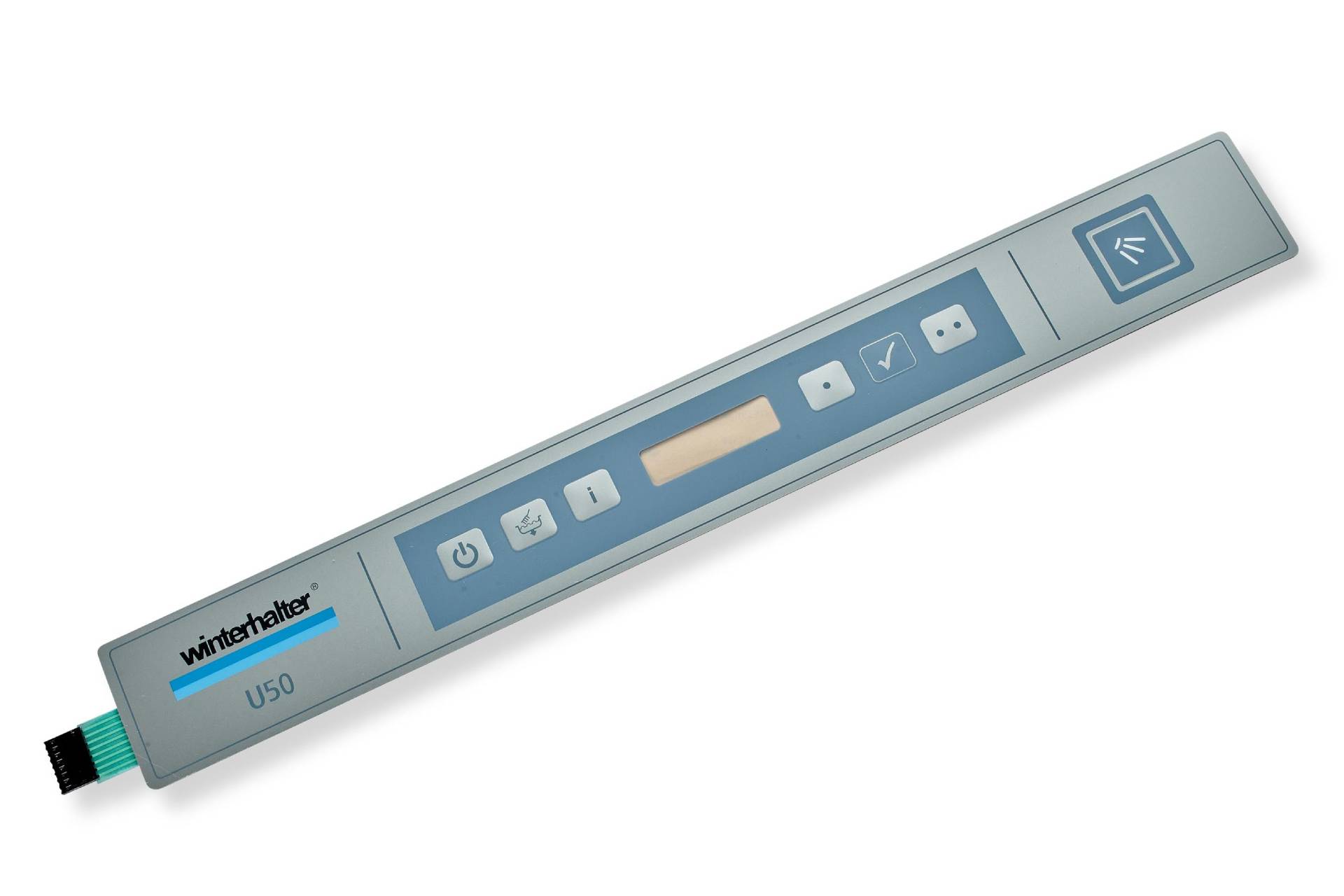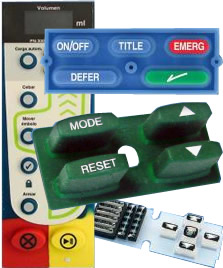Discovering the Production Process Behind Rubber Keypads and Their Significance in Modern Gadgets
Rubber keypads are critical in the functionality of modern-day gadgets. Their production process includes careful selection of products and exact techniques. Keypads are made to enhance user interaction while guaranteeing durability and reliability. Comprehending how these parts are made exposes their importance across different applications. What elements add to their performance, and exactly how do these elements influence user experience? The answers might improve understandings of this daily technology.
Summary of Rubber Keypads and Their Applications

Rubber keypads are flexible elements commonly made use of in various electronic gadgets, ranging from customer electronics to commercial equipment. Their layout enables a tactile action, making them an ideal selection for applications needing customer interaction. Frequently found in products such as remote controls, calculators, and medical devices, rubber keypads facilitate ease of use and access.
In industrial setups, they offer critical functions in equipment and control board, where resilience and resistance to ecological factors are necessary. The non-slip surface area enhances grip, promoting reliability popular problems. Additionally, their light-weight nature and personalized forms allow suppliers to develop customized options that fit specific needs. With innovations in innovation, rubber keypads proceed to develop, including functions like backlighting and improved sensitivity. In general, their adaptability and functional advantages add substantially to the efficiency of various gadgets throughout several sectors.
Products Utilized in Rubber Keypad Manufacturing
Keypad making counts on a choice of materials that improve both capability and durability. The main material made use of in the production of rubber keypads is silicone rubber, recognized for its superb resilience and adaptability. This material permits keypads to endure duplicated pushing without losing form or efficiency. In addition, polycarbonate elastomers (TPE) are frequently utilized due to their simplicity of molding and capability to supply a soft-touch feel.
Tinting representatives, such as pigments, are included to guarantee vibrant, durable colors that improve visual appeal. Moreover, ingredients like anti-UV representatives and fire retardants might be mixed into the rubber to boost climate resistance and safety and security compliance. The choice of products straight influences the keypad's tactile action, long life, and total efficiency in numerous gadgets. Ultimately, the careful selection of these elements is vital for the production of premium rubber keypads that satisfy customer and sector needs.
The Design Process of Rubber Keypads
When creating rubber keypads, the style process plays a vital duty in determining capability and user experience. Designers start by specifying the keypad's meant usage, taking into consideration elements such as the gadget it will certainly accompany and the target individual market. This first stage includes laying out formats that prioritize ergonomic aspects, guaranteeing the secrets are easily obtainable and appropriately spaced.
Next, developers focus on the tactile responses preferred from the keypads, which affects the choice of products and key shapes. Prototyping is vital in this phase, enabling developers to check numerous styles for comfort and responsiveness.

Manufacturing Techniques for Rubber Keypads
The manufacturing procedure for rubber keypads involves a series of specific strategies that ensure top quality and capability. Originally, liquid silicone rubber (LSR) is typically utilized due to its longevity and versatility. The procedure starts with blending the raw materials, consisting of silicone, colorants, and treating representatives. This mix is after that infused right into mold and mildews created to shape the keypads accurately.
Following shot, the shaped keypads undertake treating, a heating process that solidifies the material (Rubber Keypads). This is usually performed in a press, making certain the keypads accomplish the desired solidity and durability

Quality Assurance Steps in Manufacturing
To guarantee that rubber keypads fulfill high standards of top quality and capability, extensive quality assurance steps are implemented throughout the production process. These steps begin with raw product assessment, guaranteeing that just the highest-grade elastomers are used. During the production stage, drivers perform normal checks to keep an eye on criteria such as temperature level, pressure, and mixing times, crucial for achieving consistent item top quality.
Post-production, each batch of keypads goes through detailed screening, including responsive feedback analyses and durability tests to evaluate efficiency under different conditions. Aesthetic evaluations are additionally conducted to determine any flaws, such as bubbles or incongruities in structure. In addition, compliance with industry criteria is validated, guaranteeing that the keypads fulfill security and functionality benchmarks.
The Role of Innovation in Keypad Development
Innovation plays an essential duty in the advancement of rubber keypads by enabling sophisticated production techniques that boost precision and effectiveness. In addition, ingenious material option allows for improved sturdiness and responsiveness in keypad efficiency. These innovations not only improve manufacturing however likewise elevate the general top quality of the end product.
Advanced Production Techniques
Developments in production techniques change the production of rubber keypads, boosting both effectiveness and precision. Technologies such as shot molding and 3D printing have transformed standard processes, allowing producers to produce complex styles with lowered waste and improved turnaround times. Automation plays a necessary function in this evolution, simplifying production line and lessening human he has a good point mistake. In addition, computer-aided style (CAD) software application enables detailed personalization, making certain that keypads fulfill particular individual demands. Quality assurance procedures have also advanced, including real-time surveillance systems that identify defects early in the production cycle. These developments not only boost the toughness and functionality of rubber keypads but likewise sustain the expanding demand for personalized solutions in various industries, from customer electronic devices to automotive applications.
Ingenious Product Selection
The advancement of making strategies has actually led the way for innovative product selection in rubber keypad development. Advances in polymer scientific research have introduced products that improve sturdiness, adaptability, and responsive feedback. Suppliers now make use of thermoplastic elastomers (TPE) and silicone compounds, which give exceptional resistance to use and environmental variables. These products enable the development of keypads that can withstand prolonged usage while maintaining visual charm. Furthermore, the integration of layers and additives enhances performance, such as boosting grip and decreasing friction. The choice of products is vital, as it directly affects the efficiency and long life of keypads in various tools, from consumer electronic devices to industrial equipment. This ingenious technique remains to form the future of keypad design and usability.
The Impact of Rubber Keypads on User Experience
Rubber keypads greatly influence individual experience via their enhanced tactile reaction, which allows for more specific interaction. In addition, their durability and durability add to consistent efficiency with time, lowering the requirement for regular substitutes. This combination of features makes rubber keypads a recommended choice in numerous applications, eventually impacting user satisfaction.
Boosted Tactile Feedback
Enhancing tactile feedback greatly influences individual experience, particularly in gadgets that count on keypads for communication. Rubber keypads provide a distinct combination of gentleness and durability, enabling customers to feel distinctive responses with each press. This comments enhances a feeling of control and precision, important in applications varying from mobile phones to industrial devices. Users often report higher satisfaction and efficiency when communicating with gadgets that feature properly designed rubber keypads, as they promote quicker and much more precise input. Furthermore, the ergonomic style of these keypads can reduce finger fatigue, promoting longer usage durations without discomfort. Overall, the enhanced responsive response given by rubber keypads substantially adds to a more user-friendly and satisfying individual experience in modern innovation.
Durability and Long life
A key element of user experience with rubber keypads lies in their durability and longevity. These keypads are developed to stand up to substantial use, resisting wear and tear that usually affects her response various other materials. The durable nature of rubber warranties that keypads preserve their capability and look in time, which is important for devices frequently utilized in numerous settings. Users benefit from the reliability of rubber keypads, as they can endure direct exposure to dust, dampness, and temperature variations without weakening. This strength not just enhances customer satisfaction but also lowers the need for regular substitutes, eventually adding to cost-effectiveness for makers. Essentially, the longevity of rubber keypads substantially affects the total efficiency Read Full Article and customer experience in modern-day tools.
Frequently Asked Questions
The Length Of Time Do Rubber Keypads Commonly Last in Devices?
Rubber keypads typically last between 5 to 10 years, depending on usage, ecological factors, and top quality of products utilized (Rubber Keypads). Regular damage can shorten their life expectancy, influencing functionality and individual experience in time
Can Rubber Keypads Be Personalized for Specific Applications?
Rubber keypads can without a doubt be customized for specific applications, allowing alterations in dimension, structure, form, and color. This versatility enables producers to create customized remedies that satisfy varied user needs and enhance capability in numerous tools.
Are Rubber Keypads Eco-friendly?
Rubber keypads are often not considered ecologically pleasant as a result of their petroleum-based products. Innovations in lasting manufacturing techniques and the development of bio-based choices are gradually enhancing their ecological impact in different applications.
What Prevail Problems Faced During Rubber Keypad Production?
Typical issues faced throughout rubber keypad production consist of irregular worldly high quality, mold issues, inappropriate curing times, adhesion failings, and difficulties in achieving precise tactile responses. These issues can bring about lowered product efficiency and client frustration.
Exactly How Do Rubber Keypads Contrast to Various Other Sorts Of Trick Switches?
Rubber keypads provide a softer feeling and quieter operation contrasted to mechanical switches, which give responsive feedback. Rubber keypads might use out faster and lack the precision that some individuals like in high-performance applications.
The key material utilized in the production of rubber keypads is silicone rubber, known for its outstanding strength and flexibility. When producing rubber keypads, the layout process plays an essential role in determining functionality and individual experience. Rubber keypads substantially influence customer experience with their boosted responsive response, which enables for more precise interaction. Individuals often report greater fulfillment and performance when interacting with tools that include properly designed rubber keypads, as they help with quicker and much more accurate input. An essential element of individual experience with rubber keypads exists in their toughness and long life.